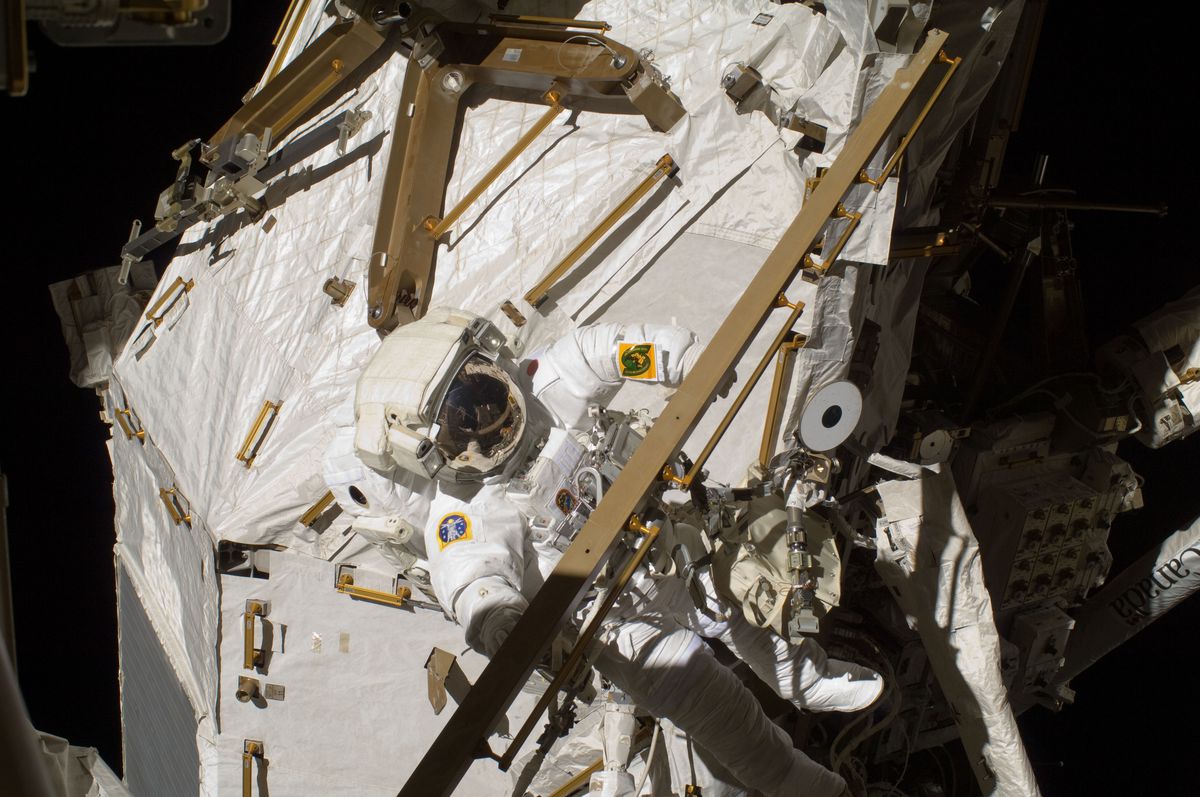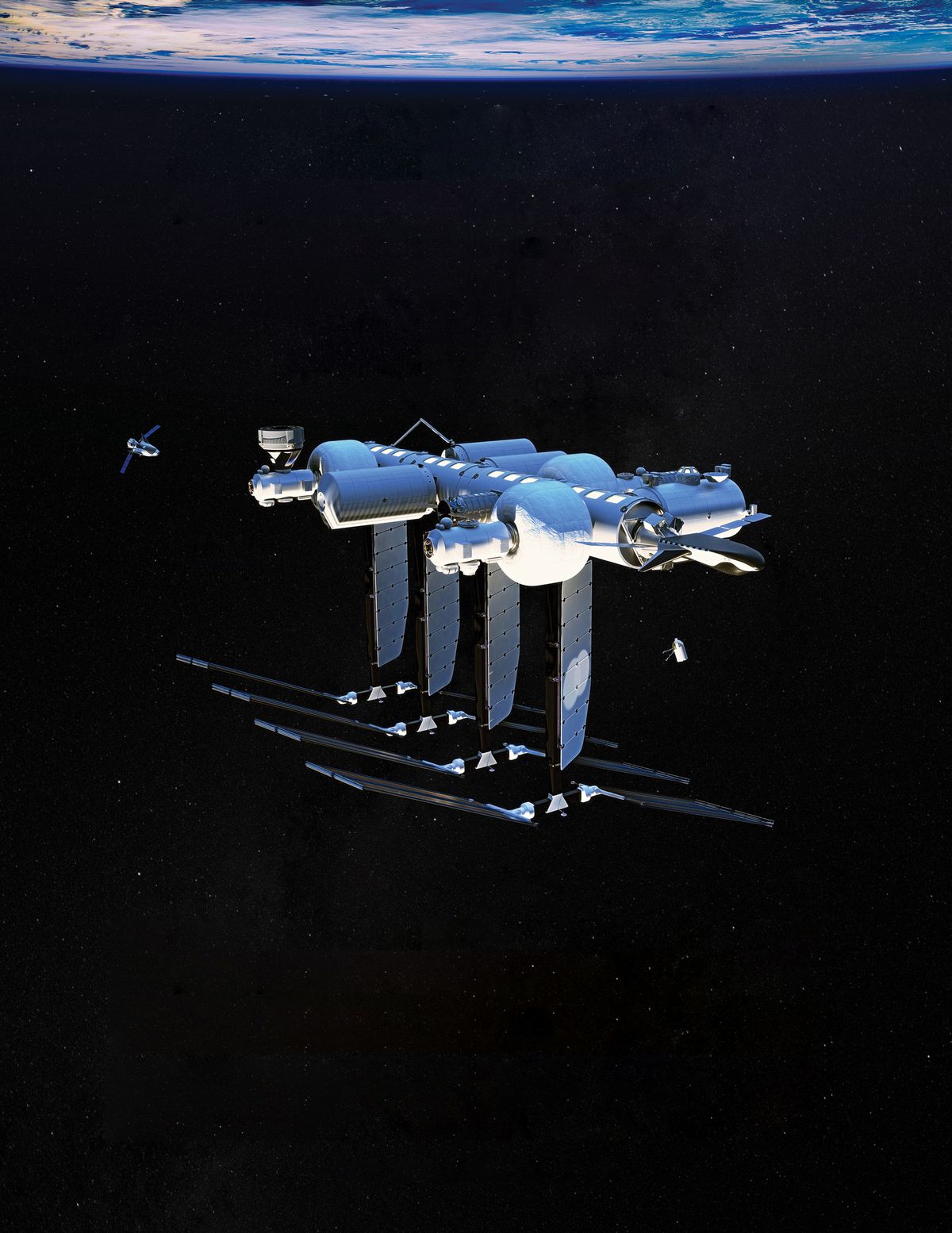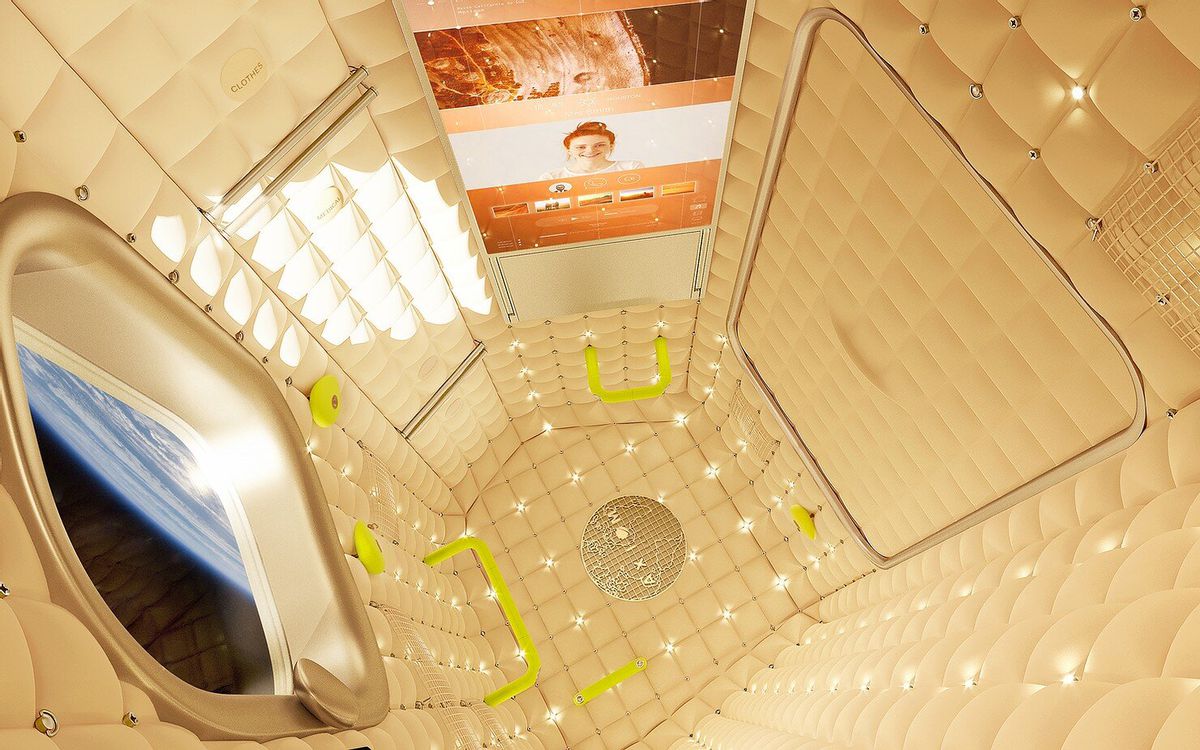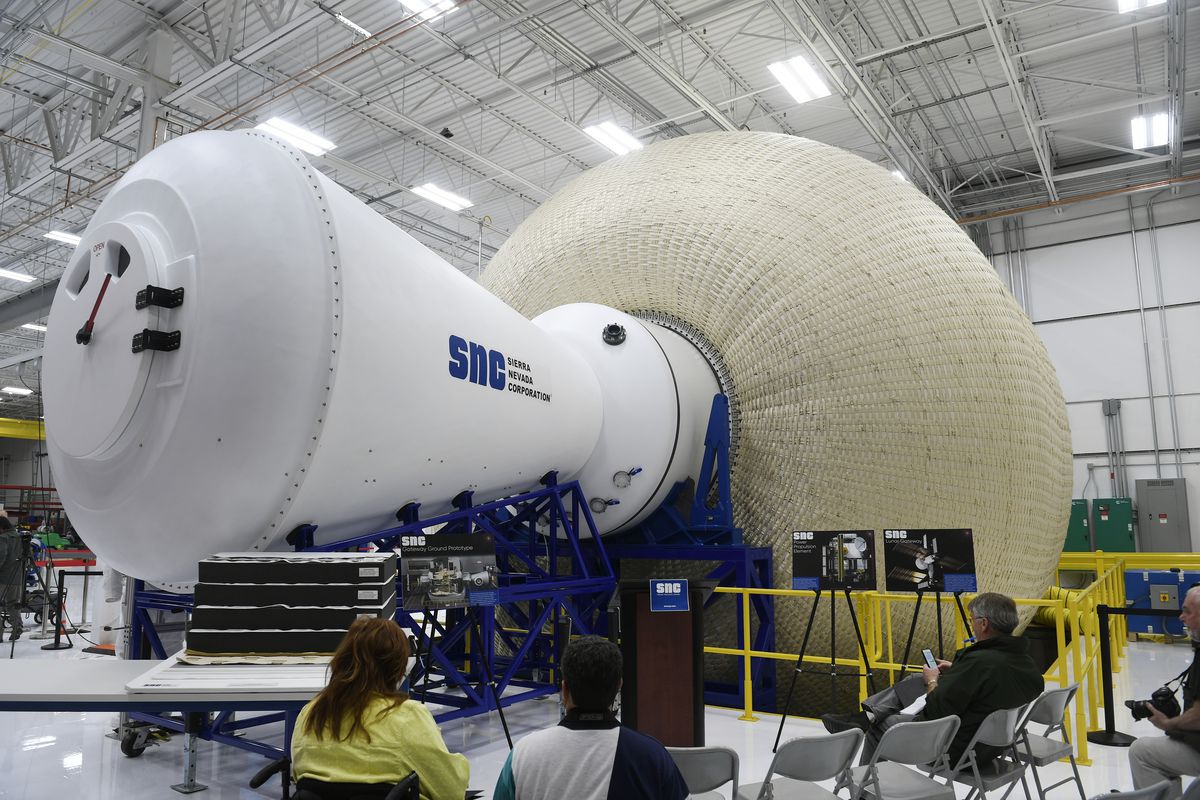The International Space Station brings together astronauts from around the world to collaborate on cutting-edge research, and some have called it humanity’s greatest achievement. But after two decades in orbit, the ISS will shut down, and a crop of several new space stations will take its place. While these new stations will make it easier for more humans to visit space, they’re also bound to create new political and economic tensions.
NASA is scaling back its presence in low-Earth orbit as the government focuses on sending humans back to the moon and, eventually, to Mars. As part of that transition, the space agency wants to rent out facilities for its astronauts on new space stations run by private companies. When these stations are ready, NASA will guide the ISS into the atmosphere, where it will burn up and disintegrate. At that point, anyone hoping to work in space will have to choose among several different outposts. That means countries won’t just be using these new stations to strengthen their own national space programs, but as lucrative business ventures, too.
“Commercial companies have the capability now to do this, and so we don’t want to compete with that,” Robyn Gatens, the director of the ISS, told Recode. “We want to transition lower-Earth orbit over to commercial companies so that the government and NASA can go use resources to do harder things in deep space.”
Private companies currently backed by NASA, including Lockheed Martin and Jeff Bezos’s Blue Origin, could launch as many as four space stations into Earth’s orbit over the next decade. NASA is also building a space station called Gateway near the moon; a SpaceX Falcon Heavy rocket carrying the living quarters for the station is scheduled to launch in 2024. Russia and India are planning to launch their own space stations to low-Earth orbit, too, and China’s Tiangong station, which is currently under construction, already has astronauts living aboard.
It’s not clear when the ISS will go offline, but it will happen. NASA has only technically certified the station’s hardware until 2028 and has awarded more than $400 million to fund private replacements. Other longtime ISS partners are already planning their next steps. Russia may leave the ISS as soon as 2025, the same year its space agency, Roscosmos, plans to launch its new $5 billion space station. The European Space Agency, which represents 22 different European countries, is now training its astronauts for eventual missions to Tiangong.
These new stations are building on technology first seen in the ISS, but they stand to make low-Earth orbit a more politically fraught place. After all, researchers looking to conduct research in space will potentially have to reckon with the political consequences of choosing one nation’s station over that of another. There will also be a new dynamic of several space stations competing for customers in the private sector.
The nascent space station race isn’t quite a return to the Cold War, but it’s not the pinnacle of internationalism, either. In the best of scenarios, these new stations will learn from each other and massively expand scientific knowledge. But they will also make global politics a much bigger part of space, which could impact what happens here on Earth and how humanity explores the moon and Mars.
NASA is downsizing in low-Earth orbit
Table of Contents
The ISS is a big operation. It took 42 assembly flights and an estimated $100 billion to build this habitable satellite made of 16 interconnected modules, where astronauts live and work, as well as eight solar arrays that power the station. The ISS serves as a shared laboratory in space, which NASA uses to study technologies that could be deployed on future missions to other planets, including oxygen- and water-recycling systems. Astronauts aboard the space station also research how to mitigate the health risks that come with living in space, like radiation exposure, muscle loss, and bone loss.
“Up in space, we can measure things that we can’t measure and we can’t observe down here,” explained Cady Coleman, a former astronaut and chemist who spent several months on the ISS.
The space station is fully functional right now. Eleven astronauts from four different countries are currently aboard the ISS, where they’ve recently added a new module, organized a spacewalk, and fixed faulty components. Much of the work on the ISS happens with the help of private companies, including major aerospace and defense firms like Northrop Grumman and Lockheed Martin. SpaceX, meanwhile, has been carrying supplies to the ISS since 2012 and started transporting astronauts to it last year.

But eventually, NASA wants to get out of the expensive business of running the ’90s-era space station. The ISS is the size of a football field and costs as much as $4 billion annually to operate, and NASA estimates that relocating its astronauts to commercial alternatives could save about $1 billion every year. Newer space stations will be smaller than the ISS and include newer tech, and NASA would only need to pay for the portion that it uses. And once these replacements are launched into orbit, the space agency can finally dispose of the ISS.
“We’re looking at ISS technology that was designed beginning in the ’80s, built in the ’90s, and launched in the ’90s and 2000s,” Wendy Whitman Cobb, a professor at the US Air Force School of Advanced Air and Space Studies, told Recode. “This is definitely aging.”
The plan is to deorbit the ISS right over an area called Point Nemo in the South Pacific Ocean, which is the world’s farthest point from land. This will be a delicate process, and could take up to three years. After letting gravity pull the ISS downward to a critical height of 155 miles above Earth, NASA will organize one final flight to remove any remaining research (or astronauts). Soon afterward, ISS operators will use a cargo spacecraft to push the ISS into the atmosphere. While most of the space station should burn off, “a number of high-density payload and structural components” are likely to break through intact, according to NASA spokesperson Stephanie Schierholz.
While letting the ISS fall to Earth might sound extreme, it’s the same approach the space agency took when it retired Skylab, the first US space station, in 1979. Engineers have been studying this plan for years, and they plan to fine-tune the workflow until the ISS is close to its final descent.
In the meantime, the goal is to keep the ISS functioning as long as possible, which will give NASA more time to prepare. To ensure that happens, a bipartisan set of lawmakers want to extend the space station’s operations until 2030, a proposal that’s currently packaged within the United States Innovation and Competition Act. NASA and Congress are now waiting on a final decision from the Biden administration.
Private companies are building their own space stations
By creating an economy in low-Earth orbit, NASA thinks it can split the cost of operating a space station with the private sector. The agency is hoping that future commercial space stations will operate like coworking spaces. This would allow NASA astronauts to use facilities in low-Earth orbit alongside astronauts from other national space agencies as well as those from the private industry. There could even be media production companies and space hotel guests on board. NASA is also betting that some companies will want to use these stations to manufacture specialty products in microgravity.
To accelerate these plans, NASA has granted seed funding to four different space station concepts. Perhaps the most high-profile grant is the $130 million going to Orbital Reef, a space station project designed by Blue Origin. The company wants this station to function as a “mixed use business park” that includes labs, 3D printers, and a garden. Blue Origin says Orbital Reef will be only slightly smaller than the ISS but would cost an “order of magnitude” less to build. Orbital Reef will also look more modern, with one large, tubular main corridor that’s lined with windows and just a single layer of solar arrays extending from one side of the spacecraft, according to renderings released by the company.

In addition to the Blue Origin project, NASA has backed StarLab — not to be confused with Skylab — a new space station being developed by commercial space company Nanoracks in partnership with Voyager Space and Lockheed Martin. There’s also a proposal from Northrop Grumman. Both StarLab and the unnamed Northrop Grumman space station plan to house up to four astronauts at a time and include lab space.
Separately, NASA has awarded over $140 million to Axiom Space, a company that’s building a module for space tourism that will attach directly to the ISS. Axiom Space hired the French industrial architect and designer Philippe Starck to design the module, which will include a two-meter-high window deck and an aesthetic meant to remind people of “a nest.” When the ISS is decommissioned, the original Axiom module will be attached to other Axiom modules to form an entirely new station.
“Because this has never been a commercial endeavor, the idea of what the market is is all fluid,” Tejpaul Bhatia, the chief revenue officer of Axiom, told Recode. “We have ideas from the research that’s been done on ISS of what kind of advantages pharma, biotech, material science, and industrial manufacturing can get in microgravity.”

This plan has its risks. NASA is betting there will be a lot of demand for commercial space stations, which are all supposed to launch around 2027. But only a fifth of ISS crew resources that NASA has set aside for private companies to develop their businesses in space have been used thus far, according to Gatens, the ISS director. And competition for customers could get even more intense as space stations launched by China, Russia, and India open for business.
These companies have committed, however, to finding enough business to support their operations. Millions of dollars of their seed funding from NASA is devoted to developing marketing plans, according to contracts with the agency that Recode accessed through a public records request. While Blue Origin has said NASA and its partners will serve as its primary customer for research, the StarLab station will only depend on NASA for 30 percent of its revenue during its first decade.
NASA can’t afford for them to fail. The agency has no plans to build an ISS replacement on its own, but NASA’s inspector general concluded in November that the agency’s critical research in microgravity — which NASA needs for missions to the moon and Mars — won’t be completed by 2030. The space agency’s worst nightmare is not having its own space station to complete that work, several space policy experts told Recode.
Two ISSs on the moon
It’s time for humankind to go back to the moon, and this time we’ll stay, according to NASA’s plans. As part of the space agency’s Artemis missions, NASA will establish a long-term human presence on the lunar surface, including a permanent habitat, a rocket launcher, and even a nuclear power plant. To make that all happen, the space agency is constructing the Gateway, a new space station that will orbit the moon.
Like the ISS, the Gateway is a collaboration between several countries and companies. The European, Canadian, and Japanese space programs are joining NASA in the effort, and several private aerospace space firms, including Lockheed Martin, Northrop Grumman, and Boeing, are also involved. SpaceX has already agreed to transport the first components for the Gateway, a habitation module and a propulsion system, on its Falcon Heavy launch system sometime in 2024.

It’s best to think of the Gateway as a transit stop or a scaled-down version of the Space Station V from 2001: A Space Odyssey. Astronauts will use the Gateway as a place to dock before landing on the moon or before traveling back to Earth. The station will be big enough to fit four astronauts for up to three months, and will also double as lab space and a “mission control” center for lunar operations. When complete, the outpost will only be a sixth of the ISS’s size. The tiny station could also play a pivotal role in plans to send humans to Mars, which NASA is hoping to do sometime in the 2030s.
“This Gateway is directly derived from all the hardware and experiences learned on the International Space Station development,” Richard Mastracchio, a former ISS astronaut and current business development director at Northrop Grumman, which is building the Gateway’s habitation module, told Recode. “There’s no reason we can’t develop and utilize the same lessons learned and a lot of the same hardware to have a space station orbiting Mars.”
On the Gateway, astronauts could simulate practice missions to Mars. Astronauts could also use the Gateway to test how well experimental technologies do in space, and the station could even be used to assemble and park vehicles headed deeper into the solar system, according to Mastracchio.
But even as NASA seeks more countries to assist with the Gateway, the space station already has some competition. China and Russia agreed in March to collaborate on moon research efforts, including the construction of an International Scientific Lunar Station. While we don’t know much about these plans yet, countries and companies looking to join an international collaboration to do research on the moon can now choose between two different space stations.
International cooperation in space is more complicated
Space has never been completed isolated from the geopolitical conflict on Earth. The first decades of the Cold War launched the initial space race between the Soviet Union and the US. But even in recent years, politics has influenced what happens in space.
Back in 2011, Congress passed legislation severely restricting NASA from collaborating with the Chinese government, which effectively barred China National Space Administration astronauts from the ISS. Roscosmos has repeatedly threatened to leave the space station in response to US sanctions on its domestic space industry. Space debris created by anti-satellite tests launched by the US, China, Russia, and India continues to fuel geopolitical tensions in space.
But those tensions could become even more complicated as the next generation of stations launch, which will allow the countries operating in space to form international collaborations beyond the ISS.
China’s Tiangong space station plans to host experiments from several other countries and is open to working with the US. New space stations planned by Russia and India are also likely to recruit partner countries and companies. And while the four commercial space stations with NASA funding present themselves as global platforms, they will legally function as American companies and will be subject to US rules limiting what countries they can work with, explains Namrata Goswami, an independent scholar of space policy.
“Anything involving space is not just about space prestige and power, but it’s also a lot about economic benefits and economic development,” Goswami told Recode. “The space industry today is about $400 billion. The space station plays a role in developing these technologies.”
These developments will create new opportunities for countries without space stations — countries like the United Arab Emirates, Nigeria, and Australia, which have wanted to send their own astronauts into space but don’t have anywhere to stay in low-Earth orbit. Which space station they choose to partner with won’t just depend on cost, but on political calculations too.
So the ISS’s eventual deorbit won’t be the end of international collaboration in space. On the contrary, it ushers in a new era of space stations, one that will make cooperation a lot more politically and economically complicated. This generation will surely remind us that humanity’s current conflicts are by no means limited to planet Earth.






